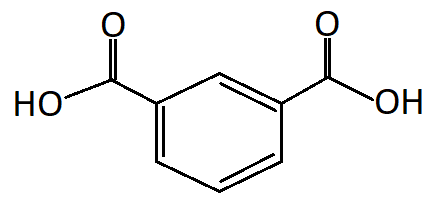Answer
396.9k+ views
Hint: Isophthalic acid is an organic compound, having the chemical formula: \[{{{C}}_{{6}}}{{{H}}_{{4}}}{{{(C}}{{{O}}_{{2}}}{{H)}}_{{2}}}\]. Isophthalic acid is an isomer of phthalic acid and terephthalic acid, all of them having two carboxylic acid groups of a benzene ring but the relative position of both the carboxylic acid groups is different in these three acids.
Complete step by step answer:
To predict the IUPAC name of isophthalic acid, let us first see what the structure of isophthalic acid is:

As can be seen in the above structure the two carboxylic acid groups are meta to each other or at a relative position of carbon-1 and carbon-3, the IUPAC name of isophthalic acid is Benzene-1,3-dicarboxylic acid.
Hence option B is the correct answer.
Some properties of isophthalic acid:
-Isophthalic acid is a colorless solid organic compound.
-It is mainly used for the industrial preparation of polyethylene terephthalate resin and unsaturated polyester resin.
-Isophthalate is prepared on an industrial scale by oxidizing meta-xylene using cobalt-manganese as a catalyst.
For laboratory preparations, chromic acid is used as an oxidizing agent to oxidize meta-xylene.
Every year approximately 1 billion kilograms of isophthalic acid is produced for industrial purposes.
Note:
Please note that IUPAC stands for the International Union of Pure and Applied Chemistry. IUPAC is the world authority on chemical nomenclature and terminology, including the naming of new elements in the periodic table; on standardized measurement methods, and atomic weights, and many other critically evaluated data. It is a neutral and objective scientific organization, established in 1919 by academic and industrial chemists who shared a common goal- to unite a fragmented global chemistry community for the advancement of chemical sciences via collaboration and the free exchange of scientific information.
Complete step by step answer:
To predict the IUPAC name of isophthalic acid, let us first see what the structure of isophthalic acid is:

As can be seen in the above structure the two carboxylic acid groups are meta to each other or at a relative position of carbon-1 and carbon-3, the IUPAC name of isophthalic acid is Benzene-1,3-dicarboxylic acid.
Hence option B is the correct answer.
Some properties of isophthalic acid:
-Isophthalic acid is a colorless solid organic compound.
-It is mainly used for the industrial preparation of polyethylene terephthalate resin and unsaturated polyester resin.
-Isophthalate is prepared on an industrial scale by oxidizing meta-xylene using cobalt-manganese as a catalyst.
For laboratory preparations, chromic acid is used as an oxidizing agent to oxidize meta-xylene.
Every year approximately 1 billion kilograms of isophthalic acid is produced for industrial purposes.
Note:
Please note that IUPAC stands for the International Union of Pure and Applied Chemistry. IUPAC is the world authority on chemical nomenclature and terminology, including the naming of new elements in the periodic table; on standardized measurement methods, and atomic weights, and many other critically evaluated data. It is a neutral and objective scientific organization, established in 1919 by academic and industrial chemists who shared a common goal- to unite a fragmented global chemistry community for the advancement of chemical sciences via collaboration and the free exchange of scientific information.
Recently Updated Pages
How many sigma and pi bonds are present in HCequiv class 11 chemistry CBSE

Why Are Noble Gases NonReactive class 11 chemistry CBSE

Let X and Y be the sets of all positive divisors of class 11 maths CBSE

Let x and y be 2 real numbers which satisfy the equations class 11 maths CBSE

Let x 4log 2sqrt 9k 1 + 7 and y dfrac132log 2sqrt5 class 11 maths CBSE

Let x22ax+b20 and x22bx+a20 be two equations Then the class 11 maths CBSE

Trending doubts
Fill the blanks with the suitable prepositions 1 The class 9 english CBSE

At which age domestication of animals started A Neolithic class 11 social science CBSE

Which are the Top 10 Largest Countries of the World?

Give 10 examples for herbs , shrubs , climbers , creepers

Difference between Prokaryotic cell and Eukaryotic class 11 biology CBSE

Difference Between Plant Cell and Animal Cell

Write a letter to the principal requesting him to grant class 10 english CBSE

Change the following sentences into negative and interrogative class 10 english CBSE

Fill in the blanks A 1 lakh ten thousand B 1 million class 9 maths CBSE



